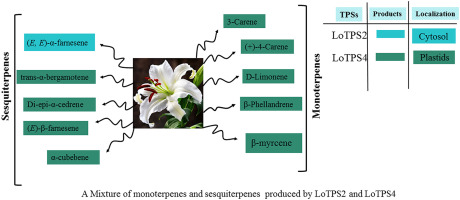当前位置:
X-MOL 学术
›
Phytochemistry
›
论文详情
Our official English website, www.x-mol.net, welcomes your feedback! (Note: you will need to create a separate account there.)
Molecular cloning, characterization and expression analysis of LoTPS2 and LoTPS4 involved in floral scent formation in oriental hybrid Lilium variety ‘Siberia’
Phytochemistry ( IF 3.8 ) Pub Date : 2020-05-01 , DOI: 10.1016/j.phytochem.2020.112294 Farhat Abbas 1 , Yanguo Ke 1 , Yiwei Zhou 1 , Umair Ashraf 2 , Xinyue Li 1 , Yunyi Yu 1 , Yuechong Yue 1 , Kanwar Waqas Ahmad 1 , Rangcai Yu 3 , Yanping Fan 4
Phytochemistry ( IF 3.8 ) Pub Date : 2020-05-01 , DOI: 10.1016/j.phytochem.2020.112294 Farhat Abbas 1 , Yanguo Ke 1 , Yiwei Zhou 1 , Umair Ashraf 2 , Xinyue Li 1 , Yunyi Yu 1 , Yuechong Yue 1 , Kanwar Waqas Ahmad 1 , Rangcai Yu 3 , Yanping Fan 4
Affiliation

|
Lilies are a commercially significant cut flower worldwide due not only to their elegant shape but also to their appealing scent. Among Lilium varieties, Lilium 'Siberia' is a cultivar that is prominent and highly favored by consumers due to its snowy white color and strong floral scent. Here, two terpene synthase genes (LoTPS2 and LoTPS4) that are responsible for floral scent production in Lilium 'Siberia' were cloned and functionally characterized. Recombinant LoTPS2 specifically catalyzed the formation of (E, E)-α-farnesene from FPP. Recombinant LoTPS4 is a multiproduct enzyme that produces D-limonene and β-myrcene as major volatile compounds and β-phellandrene, (+)-4-carene and 3-carene as minor products from GPP. Furthermore, LoTPS4 generates trans-α-bergamotene as a major product and di-epi-α-cedrene, α-cubebene and (E)-β-farnesene as minor compounds from FPP. Subcellular localization analysis using GFP fusion constructs revealed that LoTPS2 was localized in the cytosol, whereas LoTPS4 was localized in plastids. Real-time PCR analysis showed that LoTPS2 was highly expressed in the petals and sepals of the flower, while LoTPS4 was highly expressed in the filament of the flower. Moreover, mechanical wounding of flowers revealed that LoTPS2 showed a strong response to wounding via a rapid increase in its mRNA transcript level. Our results will assist scientists in exploring the molecular mechanisms of terpene biosynthesis in this species and will provide new insight into the biotechnological modification of the floral bouquet in Lilium.
中文翻译:

LoTPS2和LoTPS4参与东方杂交百合品种'西伯利亚'花香味形成的分子克隆、表征和表达分析
百合是一种世界范围内具有重要商业价值的切花,不仅因为它们优雅的形状,还因为它们迷人的香味。在百合品种中,“西伯利亚”百合因其雪白的颜色和浓郁的花香而备受消费者青睐。在这里,负责在百合“西伯利亚”中产生花香的两个萜烯合酶基因(LoTPS2 和 LoTPS4)被克隆并进行了功能表征。重组 LoTPS2 特异性催化 FPP 形成 (E, E)-α-法呢烯。重组 LoTPS4 是一种多产物酶,可产生 D-柠檬烯和 β-月桂烯作为主要挥发性化合物,以及 β-水芹烯、(+)-4-carene 和 3-carene 作为 GPP 的次要产物。此外,LoTPS4 产生反式-α-佛手柑烯作为主要产物和双表-α-雪松烯,α-cubebene 和 (E)-β-farnesene 作为 FPP 的次要化合物。使用 GFP 融合构建体的亚细胞定位分析显示 LoTPS2 定位在细胞质中,而 LoTPS4 定位在质体中。Real-time PCR分析表明LoTPS2在花的花瓣和萼片中高表达,而LoTPS4在花的花丝中高表达。此外,花的机械损伤表明 LoTPS2 通过其 mRNA 转录水平的快速增加对损伤表现出强烈的反应。我们的研究结果将帮助科学家探索该物种萜烯生物合成的分子机制,并将为百合花束的生物技术改造提供新的见解。使用 GFP 融合构建体的亚细胞定位分析显示 LoTPS2 定位在细胞质中,而 LoTPS4 定位在质体中。Real-time PCR分析表明LoTPS2在花的花瓣和萼片中高表达,而LoTPS4在花的花丝中高表达。此外,花朵的机械损伤表明 LoTPS2 通过其 mRNA 转录水平的快速增加对损伤表现出强烈的反应。我们的研究结果将帮助科学家探索该物种萜烯生物合成的分子机制,并将为百合花束的生物技术改造提供新的见解。使用 GFP 融合构建体的亚细胞定位分析显示 LoTPS2 定位在细胞质中,而 LoTPS4 定位在质体中。Real-time PCR分析表明LoTPS2在花的花瓣和萼片中高表达,而LoTPS4在花的花丝中高表达。此外,花朵的机械损伤表明 LoTPS2 通过其 mRNA 转录水平的快速增加对损伤表现出强烈的反应。我们的研究结果将帮助科学家探索该物种萜烯生物合成的分子机制,并将为百合花束的生物技术改造提供新的见解。Real-time PCR分析表明LoTPS2在花的花瓣和萼片中高表达,而LoTPS4在花的花丝中高表达。此外,花朵的机械损伤表明 LoTPS2 通过其 mRNA 转录水平的快速增加对损伤表现出强烈的反应。我们的研究结果将帮助科学家探索该物种萜烯生物合成的分子机制,并将为百合花束的生物技术改造提供新的见解。Real-time PCR分析表明LoTPS2在花的花瓣和萼片中高表达,而LoTPS4在花的花丝中高表达。此外,花朵的机械损伤表明 LoTPS2 通过其 mRNA 转录水平的快速增加对损伤表现出强烈的反应。我们的研究结果将帮助科学家探索该物种萜烯生物合成的分子机制,并将为百合花束的生物技术修饰提供新的见解。
更新日期:2020-05-01
中文翻译:

LoTPS2和LoTPS4参与东方杂交百合品种'西伯利亚'花香味形成的分子克隆、表征和表达分析
百合是一种世界范围内具有重要商业价值的切花,不仅因为它们优雅的形状,还因为它们迷人的香味。在百合品种中,“西伯利亚”百合因其雪白的颜色和浓郁的花香而备受消费者青睐。在这里,负责在百合“西伯利亚”中产生花香的两个萜烯合酶基因(LoTPS2 和 LoTPS4)被克隆并进行了功能表征。重组 LoTPS2 特异性催化 FPP 形成 (E, E)-α-法呢烯。重组 LoTPS4 是一种多产物酶,可产生 D-柠檬烯和 β-月桂烯作为主要挥发性化合物,以及 β-水芹烯、(+)-4-carene 和 3-carene 作为 GPP 的次要产物。此外,LoTPS4 产生反式-α-佛手柑烯作为主要产物和双表-α-雪松烯,α-cubebene 和 (E)-β-farnesene 作为 FPP 的次要化合物。使用 GFP 融合构建体的亚细胞定位分析显示 LoTPS2 定位在细胞质中,而 LoTPS4 定位在质体中。Real-time PCR分析表明LoTPS2在花的花瓣和萼片中高表达,而LoTPS4在花的花丝中高表达。此外,花的机械损伤表明 LoTPS2 通过其 mRNA 转录水平的快速增加对损伤表现出强烈的反应。我们的研究结果将帮助科学家探索该物种萜烯生物合成的分子机制,并将为百合花束的生物技术改造提供新的见解。使用 GFP 融合构建体的亚细胞定位分析显示 LoTPS2 定位在细胞质中,而 LoTPS4 定位在质体中。Real-time PCR分析表明LoTPS2在花的花瓣和萼片中高表达,而LoTPS4在花的花丝中高表达。此外,花朵的机械损伤表明 LoTPS2 通过其 mRNA 转录水平的快速增加对损伤表现出强烈的反应。我们的研究结果将帮助科学家探索该物种萜烯生物合成的分子机制,并将为百合花束的生物技术改造提供新的见解。使用 GFP 融合构建体的亚细胞定位分析显示 LoTPS2 定位在细胞质中,而 LoTPS4 定位在质体中。Real-time PCR分析表明LoTPS2在花的花瓣和萼片中高表达,而LoTPS4在花的花丝中高表达。此外,花朵的机械损伤表明 LoTPS2 通过其 mRNA 转录水平的快速增加对损伤表现出强烈的反应。我们的研究结果将帮助科学家探索该物种萜烯生物合成的分子机制,并将为百合花束的生物技术改造提供新的见解。Real-time PCR分析表明LoTPS2在花的花瓣和萼片中高表达,而LoTPS4在花的花丝中高表达。此外,花朵的机械损伤表明 LoTPS2 通过其 mRNA 转录水平的快速增加对损伤表现出强烈的反应。我们的研究结果将帮助科学家探索该物种萜烯生物合成的分子机制,并将为百合花束的生物技术改造提供新的见解。Real-time PCR分析表明LoTPS2在花的花瓣和萼片中高表达,而LoTPS4在花的花丝中高表达。此外,花朵的机械损伤表明 LoTPS2 通过其 mRNA 转录水平的快速增加对损伤表现出强烈的反应。我们的研究结果将帮助科学家探索该物种萜烯生物合成的分子机制,并将为百合花束的生物技术修饰提供新的见解。



























 京公网安备 11010802027423号
京公网安备 11010802027423号